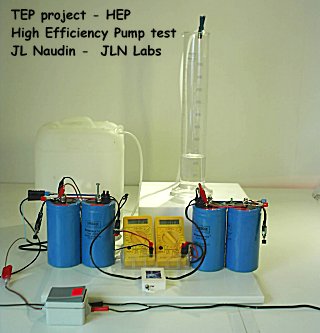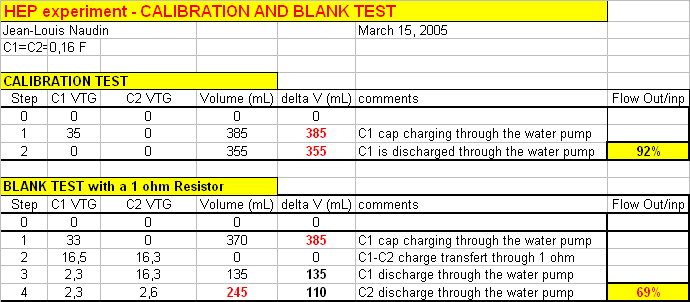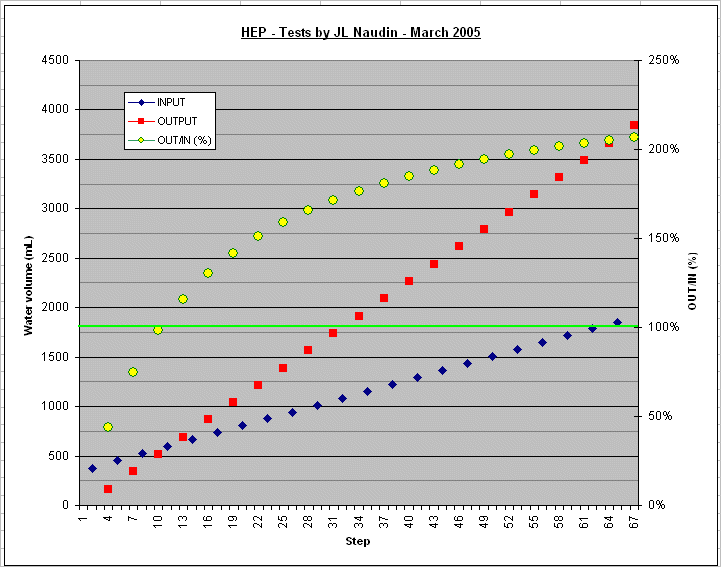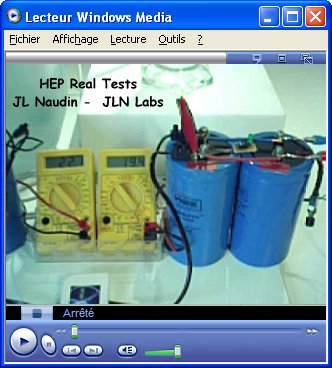
The High Efficiency Pump
experiment
A part of the TEP project
by JL Naudin
created on March 14, 2003 - JLN
Labs - Last update April 25, 2005
Toutes les
informations et schémas sont publiés gratuitement ( freeware )
et sont destinés à un usage personnel et non commercial
All informations and
diagrams are published freely (freeware) and are intended for a private use and a non commercial
use.
The HEP ( High Efficiency Pump ) experiment is a direct use of the TEP
technology presented in this web site. During this serie of
videos experiments some very interesting facts will be
demonstrated :
The TEP
technology is a full solid state device which use cheap and common
electronic components.
The TEP is
very interesting device which demonstrates easily that electrostatic
charges can be created in closed system in spite of the Law of charge
conservation 1,2,3 introduced
by Benjamen Franklin (1706-1790) :

The HEP
experiment is the use of a common and cheap water pump in
conjunction with the TEP technology for building a High
Efficiency water pump device.
The HEP
experiment uses a water pump to convert the charges flow
into mechanical work4, driving a pump and rising water.
The HEP
experiment demonstrates easily that when the TEP device
is used more than 250% of water can be raised than
without it.
The HEP
experiment is fully and easily replicable.
The HEP is
fully scalable.
The HEP/TEP
device is not yet a true overunity device is energy term,
but it is able to produce a highly efficient mechanical
work by
converting motion of charges which has created itself than any conventional solid state
devices.

Above : The full setup of the
HEP experiment

The HEP experiment uses a DC immersed
pump to rise water.
The water level is accurately measured with a 1000 mL graduated
test tube.


The TEP unit is a full solid state
device. A switch allows to bypass the TEP circuit.
HEP Testing - Experimental
results
Calibration test of the water pump : The purpose of this test is to measure
the losses of the water pump equipment. The test procedure is as
follow :
Step 1, the
cap C1 is charged through the water pump, the water
volume is noted (385 mL).
Step 2, the
cap C1 is discharged through the water pump, the water
volume is noted (355 mL).
The losses can be
easily calculated and this give an measurement efficiency of 92%
(8% of losses).
HEP Blank test with a 1 ohm resistor : The purpose of this test is to conduct a
blank test of the charge transfert with the water pump equipment.
The TEP device is replaced by an 1 ohm resistor. The test
procedure is as follow :
Step 1, the
cap C1 is charged through the water pump, the water
volume is noted (385 mL).
Step 2, the
charge of the cap C1 is transfered through the 1 ohm
resistor to the cap C2, V(C1) = V(C2).
Step 3, the
cap C1 is discharged through the water pump, the water
volume is noted (135 mL).
Step 4, the
cap C2 is discharged through the water pump, the water
volume is noted (110 mL).
This test is fully in
line with the charge conservation law. V(C1)=V(C2) and
the total charge is <= initial charge. The final volume of
water transfered ( 135 mL + 110 mL = 245 mL ) is lower than the
initial volume ( 355 mL, see the calibration test step 2).
The measured
efficiency of the charge transfert through an 1 ohm resistor is
69%

Above : The experimental results of the
calibration and the blank tests.

Above : If the BLANK test is repeated, the
efficiency never exceed 100%
The BLANK test is
fully in line with the charge conservation law...
HEP REAL test with the TEP unit : The purpose of this test is to conduct a
real test of the charge transfert with the water pump equipment.
The TEP device is now connected instead of the 1 ohm resistor.
The test procedure is as follow :
Step 1, the
cap C1 is charged through the water pump, the water
volume is noted.
Step 2, the
charge of the cap C1 is transfered through the 1 ohm
resistor to the cap C2,
Step 3, the
cap C1 is discharged through the water pump, the water
volume is noted.
Step 4, the
cap C2 is discharged through the water pump, the water
volume is noted.
The measured
efficiency of the Test RUN #1 during of the charge transfert
through the TEP is up to 264%.
The measured efficiency of the Test RUN #2 during of the charge
transfert through the TEP is up to 250%.
A full and detailled
video of the Test RUN #2 have been recorded (see below)

Above, tests
RUN# 1 with the TEP active :
You may notice that 185 mL of
water (step #9) is raised
while only 70
mL of water (step #7) is used
to pre-charge the main capacitor C1.
In this test, a total charge of 1.85 Coulomb is created by the
TEP...

Above, tests
RUN# 2 with the TEP active :
You may notice that 175 mL of
water (step #9) is raised
while only 70
mL of water (step #7) is used
to pre-charge the main capacitor C1.
In this test, a total charge of 1.41 Coulomb is created by the
TEP...
In any case, the
tests with the TEP unit doesn't respect the charge
conservation law...

Above : The diagram above shows the total flow
measured at the input Vs the total flow measured at the output,
if the HEP Real test is repeated, the efficiency exceed quickly
100%
you may notice that after the step #12, the HEP begins very
efficient.

Below, you may see
by yourself the full videos of the HEP TEST RUN.
Video #1 - Introduction to the
HEP experiment

Click
on the picture to see the demo (991 kb)
Video #2 - Calibration Test

Click
on the picture to see the demo (1.74 Mb)
Video #3 - BLANK Test

Click
on the picture to see the demo (2.69 Mb
Video #4 - The real HEP test with
the TEP

Click
on the picture to see the demo (7.54 Mb)


In the test above, the water pump has been replaced by a
12V/20W halogen lamp, C1=C2 = 21000µF at 50V
The current flowing at the INPUT is compared to the current at
the OUTPUT
with the TEP disabled (bypass mode) and with the TEP enabled
(active mode).
You may observe clearly that electric charges are created ( Q=I*t
) when the TEP is actived.
Reference documents
:
The charge
conservation law demonstration by the Harvard University
Conservation
of charge demo
The Law of
charge conservation
Energy stored
in a capacitor experiment by the Harvard University
 The
Bearden's Free Energy Collector explained
The
Bearden's Free Energy Collector explained
For more informations : JNaudin509@aol.com
Return
to the JLN Labs page


















